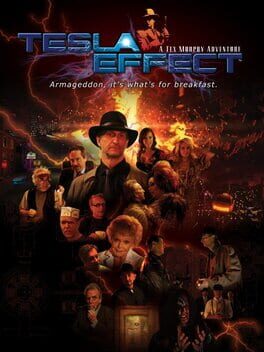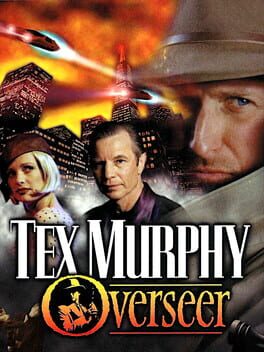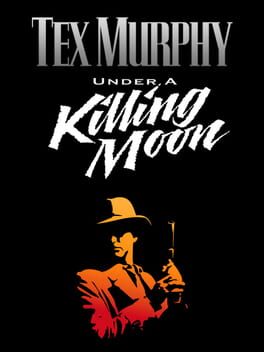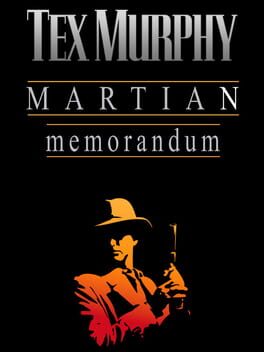

The year is 2033. Your name is Tex Murphy, Private Investigator in San Francisco. You've been hired by the beautiful daughter of a university professor to uncover the facts about his death. As you begin your investigation you uncover the deaths of several prominent members of the scientific community. Are these deaths coincidental or is there something more sinister going on? And which characters could have a motive? Could it be J. Saint Gideon, former head of British Intelligence? Could Frank Schimming, president of the largest surveillance company in the world be hiding something? Or what about Sylvia, the professor's daughter. Is she as innocent as she seems? And why is an infamous Detroit hit man in town?
Also in series
Released on
Genres
Reviews View More
An interesting adventure game that also includes side scrolling shooting scenes and a time wasting flight simulator that has high production values for the time though it is lacking in the over the top Sierra Entertainment style deaths with the at times random deaths here often giving you no more than text.
Tex Murphy is a detective working in a post-apocalyptic San Francisco in the year 2033. He is hired by Sylvia Linsky to look into her father's recent death that was declared a suicide, she both believes it to be murder and wants his life insurance policy to pay out the money that was denied her. You are given a few leads and have to choose where to begin with the case taking you around California and Nevada as you investigate the fascist Law and Order political party and their backers that were involved with Linsky and other scientists working on a mind control project.
You enter a flying speeder that you pilot to different landing locations to access areas or to meet people. These flight sim moments are a complete waste of time, there is nothing to do but fly, you are unable to crash, and there is basically nothing to see or hear while flying. What you can do to make it more bearable is to enter auto pilot navigation coordinates so the speeder flies itself, allowing you to go do something else while the game does this and making the inclusion of these moments even more questionable outside of some badly thought out piracy protection due to your early coordinates being in the game's manual. The speeder is also where you can save your game or contact two people through your video phone that you might be able to get additional information from.
Traveling to a location can lead to a few different kinds of events. You can go somewhere where you just meet a person who is represented in a picture with their dialogue underneath where you can type in questions to ask them or attempt to bribe or threaten them if they refuse to give you information. You might enter an area where you just get a full screen of text detailing your investigation or a minor character you meet. You might enter a side scrolling shooting section where you fight an infinite number of enemies and pass the section by advancing all the way to the right twice while crouching to avoid bullets and shooting enemies in your path. These short and passable for the PC at the time sections are made worse by you actually being able to run out of bullets and possibly needing to pawn items or make money hunting bounties (with a nav coordinate and combat encounter) in order to get money to pay for more ammo and to pay for bribes. In these conversations you are trying to find out new information and keywords that might work in other conversations or to gain access to new navigation codes for unexplored locations. The final type of area you can access is an actual location where the game appears more like a more common style of adventure game, only you have no point and click interface and your choices aren't handled by typing text either. Instead you select locations given to you that have interactable objects with you then choosing a few different options for how you want to interact look, get, move, open, on/off, and taste (typically just to lead to jokes or possibly a sudden ways to kill yourself).
For 1989 the game looks good with some nice background and digitized photos of actors when you get into conversations with the game's characters. The Real Sound also gives you moments of short but good quality voiced lines. Music variety is limit to one track but it is good and the sound effects are also of high quality for the time when they play.
Its a good adventure game with good production for the time that has some of the humor the later FMV games in the series are known for and a game that would have been even better if it just stuck to the one genre without generic bad (and out of place) 80s PC shooting scenes and a flight simulator that seems designed more to put you to sleep and to make sure you are keeping track of navigation codes then to entertain you.
The game was somewhat remade in Tex Murphy: Overseer but the framing was as Tex telling the story of an early case with some plot elements changed.
Screenshots: https://twitter.com/Legolas_Katarn/status/1757921208736292881
Tex Murphy is a detective working in a post-apocalyptic San Francisco in the year 2033. He is hired by Sylvia Linsky to look into her father's recent death that was declared a suicide, she both believes it to be murder and wants his life insurance policy to pay out the money that was denied her. You are given a few leads and have to choose where to begin with the case taking you around California and Nevada as you investigate the fascist Law and Order political party and their backers that were involved with Linsky and other scientists working on a mind control project.
You enter a flying speeder that you pilot to different landing locations to access areas or to meet people. These flight sim moments are a complete waste of time, there is nothing to do but fly, you are unable to crash, and there is basically nothing to see or hear while flying. What you can do to make it more bearable is to enter auto pilot navigation coordinates so the speeder flies itself, allowing you to go do something else while the game does this and making the inclusion of these moments even more questionable outside of some badly thought out piracy protection due to your early coordinates being in the game's manual. The speeder is also where you can save your game or contact two people through your video phone that you might be able to get additional information from.
Traveling to a location can lead to a few different kinds of events. You can go somewhere where you just meet a person who is represented in a picture with their dialogue underneath where you can type in questions to ask them or attempt to bribe or threaten them if they refuse to give you information. You might enter an area where you just get a full screen of text detailing your investigation or a minor character you meet. You might enter a side scrolling shooting section where you fight an infinite number of enemies and pass the section by advancing all the way to the right twice while crouching to avoid bullets and shooting enemies in your path. These short and passable for the PC at the time sections are made worse by you actually being able to run out of bullets and possibly needing to pawn items or make money hunting bounties (with a nav coordinate and combat encounter) in order to get money to pay for more ammo and to pay for bribes. In these conversations you are trying to find out new information and keywords that might work in other conversations or to gain access to new navigation codes for unexplored locations. The final type of area you can access is an actual location where the game appears more like a more common style of adventure game, only you have no point and click interface and your choices aren't handled by typing text either. Instead you select locations given to you that have interactable objects with you then choosing a few different options for how you want to interact look, get, move, open, on/off, and taste (typically just to lead to jokes or possibly a sudden ways to kill yourself).
For 1989 the game looks good with some nice background and digitized photos of actors when you get into conversations with the game's characters. The Real Sound also gives you moments of short but good quality voiced lines. Music variety is limit to one track but it is good and the sound effects are also of high quality for the time when they play.
Its a good adventure game with good production for the time that has some of the humor the later FMV games in the series are known for and a game that would have been even better if it just stuck to the one genre without generic bad (and out of place) 80s PC shooting scenes and a flight simulator that seems designed more to put you to sleep and to make sure you are keeping track of navigation codes then to entertain you.
The game was somewhat remade in Tex Murphy: Overseer but the framing was as Tex telling the story of an early case with some plot elements changed.
Screenshots: https://twitter.com/Legolas_Katarn/status/1757921208736292881
Got around to streaming and playing this and I wasn't entirely certain what to expect with this game, but I'll try my best to be fair both considering the time it was made, but also by certain modern standards where applicable and fair.
Tex Murphy: Mean Streets is the first of the Tex Murphy series. The latest, being a kickstarted project named "Tesla Effect" that I know little about as I try to enter all these games without prior knowledge. That said, much of the prologue is contained in the instructions due to limitations at the time.
Like any mystery, this starts with a death, a PI and a young woman begging you to listen to her. The young woman's father was a scientist named Carl Linsky and he was found dead in the river after jumping off the Golden Gate Bridge. The police and Tex initially think suicide, however, she begs him that it can't be the case since Carl nearly drowned in that river and was terrified of going anywhere near it so him committing suicide there was extremely unusual. Armed with this knowledge, you get taken down a rabbit-hole of science experiments, a political party and a suspiciously high number of scientists committing suicide. I'll keep the rest a secret, but beyond the mystery of Carl Linsky's death, there's a lot of dark humour in this noir-style Sci-fi detective game and for a deeper look, here's my first part of the game
Continuing on however, I do have a few issues, but also some praises. Now the "FMV" factor of this game is pretty light as it's about as much motion as the infamous "Plumbers don't wear ties", but where that game failed to do anything competently, this game excelled in many of those areas. The mystery has you hooked, your contacts are semi-animated on your video phone and you have a large variety of things to talk to people about that the instruction booklet even recommends to you. Beyond that, the mystery unfolds organically and for entertainment value when investigating you have the typical options for a early point-and-click game "look, move, take, use, on/off" but you have "taste" as an option too, leaving to some hilarious dialog which either makes Tex seem crazy or the computer just starts calling you a stupid. You also get some other fun bits of dialog like when tasting a painting Tex says "Art is a matter of taste, right?" and many other similar bad jokes. You can also get electrocuted from licking light switches which I do not recommend anyone do.
I was surprised that there are a number of shooting segments in this game. 3rd-person 2D side-scrolling shooting which was quite fun, but kind of annoying as it seemed there was a never-ending supply of enemies in every location and they were all the same with the same weapons, but you had cover and they never fire down to moving through gunfire is actually fairly easy and fun.
To cover the negative, the issues I have are the usual ones seen in many point-and-click games where at times it isn't too obvious where you need to go or what clue you may not have picked up on, but that's a minor thing. The other though, which is pretty big, is the flying. Now I am sooooo damn glad that they have it where you have a autopilot to take you to a destination, however, it isn't perfect and every location you have to fly to in real time which really drags the game down and meant I had to cut off large segments of my stream because of how all you're seeing is that you pass vague shapes. You also have the sound of the engine (which you can disable) but there isn't much else and extra long trips, especially when you aren't certain where to go, can be draining, but that's about it for negativity imo.
This is a world where apparently nuclear war happened, mutants and heavily armed fascists are on the streets and most surprising yet! Michael J. Fox is president!
9/10 I licked a light switch and it's taste was shocking.
Tex Murphy: Mean Streets is the first of the Tex Murphy series. The latest, being a kickstarted project named "Tesla Effect" that I know little about as I try to enter all these games without prior knowledge. That said, much of the prologue is contained in the instructions due to limitations at the time.
Like any mystery, this starts with a death, a PI and a young woman begging you to listen to her. The young woman's father was a scientist named Carl Linsky and he was found dead in the river after jumping off the Golden Gate Bridge. The police and Tex initially think suicide, however, she begs him that it can't be the case since Carl nearly drowned in that river and was terrified of going anywhere near it so him committing suicide there was extremely unusual. Armed with this knowledge, you get taken down a rabbit-hole of science experiments, a political party and a suspiciously high number of scientists committing suicide. I'll keep the rest a secret, but beyond the mystery of Carl Linsky's death, there's a lot of dark humour in this noir-style Sci-fi detective game and for a deeper look, here's my first part of the game
Continuing on however, I do have a few issues, but also some praises. Now the "FMV" factor of this game is pretty light as it's about as much motion as the infamous "Plumbers don't wear ties", but where that game failed to do anything competently, this game excelled in many of those areas. The mystery has you hooked, your contacts are semi-animated on your video phone and you have a large variety of things to talk to people about that the instruction booklet even recommends to you. Beyond that, the mystery unfolds organically and for entertainment value when investigating you have the typical options for a early point-and-click game "look, move, take, use, on/off" but you have "taste" as an option too, leaving to some hilarious dialog which either makes Tex seem crazy or the computer just starts calling you a stupid. You also get some other fun bits of dialog like when tasting a painting Tex says "Art is a matter of taste, right?" and many other similar bad jokes. You can also get electrocuted from licking light switches which I do not recommend anyone do.
I was surprised that there are a number of shooting segments in this game. 3rd-person 2D side-scrolling shooting which was quite fun, but kind of annoying as it seemed there was a never-ending supply of enemies in every location and they were all the same with the same weapons, but you had cover and they never fire down to moving through gunfire is actually fairly easy and fun.
To cover the negative, the issues I have are the usual ones seen in many point-and-click games where at times it isn't too obvious where you need to go or what clue you may not have picked up on, but that's a minor thing. The other though, which is pretty big, is the flying. Now I am sooooo damn glad that they have it where you have a autopilot to take you to a destination, however, it isn't perfect and every location you have to fly to in real time which really drags the game down and meant I had to cut off large segments of my stream because of how all you're seeing is that you pass vague shapes. You also have the sound of the engine (which you can disable) but there isn't much else and extra long trips, especially when you aren't certain where to go, can be draining, but that's about it for negativity imo.
This is a world where apparently nuclear war happened, mutants and heavily armed fascists are on the streets and most surprising yet! Michael J. Fox is president!
9/10 I licked a light switch and it's taste was shocking.
Clearly incredibly ambitious for the time, and the constant genre shifts did keep me interested. However there is a huge divide between what it does well (the story and investigation mechanics) and what it does poorly (travel and combat). In fact, you'll probably spend 70% of your time not even touching the keyboard, as your ship jitters from place to place with the autopilot (unless you want to control it manually, flight sim is just another game mode here lol)
For what its worth I didn't hate my time with it and I look forward to seeing how the franchise evolves from here.
For what its worth I didn't hate my time with it and I look forward to seeing how the franchise evolves from here.
Uno dei papà dei giochi investigativi contemporanei, con una quantità di problemi assurda: sequenze di viaggio con il proprio veicolo che diventano noiose già dopo una ventina di minuti (figurarsi dopo aver giocato diverse ore), impossibilità di aprire l'inventario quando ci si trova in una stanza (non che sia davvero necessario, dato che gli oggetti vengono automaticamente utilizzati dal personaggio quando ne ha la possibilità, es.: una chiave verrà automaticamente usata per aprire la corrispondente cassaforte), funzione-bustarella/minaccia troppo poco sviluppata per essere effettivamente interessante, e, qualora si volesse tentare di allungare la bustarella per ottenere un indizio o un'informazione, è anche impossibile associare un prezzo a quello che dovremmo ottenere. Un'informazione che varrebbe $200 potremmo tranquillamente pagarla $1000, mentre l'alternativa sarebbe partire sempre dalla somma più bassa possibile in attesa di arrivare a una somma accettabile secondo il nostro interlocutore (ma questo non è per nulla enigmatico e diventa, a sua volta, subito inutilmente noioso).
Nonostante questi e altri problemi, il gioco mi risulta comunque estremamente affascinante e non intendo assolutamente isolarlo del tutto, nella valutazione, dall'anno di uscita e dalla rosa di altri giochi d'avventura a esso contemporanei (e, perché no, punta-e-clicca seppur qui non si segua esattamente tale modalità di game-loop). Non che sia per forza necessario: un giocatore di oggi non potrà dimostrare apprezzamento per il comparto audio di Mean Streets (assai valido, all'epoca), ma potrà farlo verso altri elementi al di là di un discorso puramente storico.
I puzzle, per quanto semplici, sono spesse volte ben pensati e permettono di proseguire bloccandosi raramente; i personaggi sono tutti memorabili seppur monodimensionali, e per quanto abbiano poco da condividere col giocatore offrono (quasi) sempre informazioni essenziali al caso (anche se alcune le avrete già acquisite per vie traverse), senza perdersi in chiacchiere (cosa che valuterei normalmente in modo negativo ma non in questo caso, dato che il gioco si concentra unicamente sull'indagine e non è interessato a far conoscere il mondo in cui i fatti avvengono, facendo eccezione per una particolare città in cui ci si può recare verso metà partita); i colori e i disegni adottati per i vari fondali sono vibranti (sì) e piacevoli da osservare; la possibilità di indagare a proprio piacimento in un luogo anziché in un altro, e di interloquire prima con un personaggio e successivamente con un altro, consegna maggiore libertà al giocatore e gli permette di raccogliere informazioni in modi e tempi differenti; non c'è nessuna possibilità di appuntare in-game la grossa mole di informazioni che si ottengono man mano (in particolare nomi e codici/indirizzi), pertanto il giocatore è tenuto a farlo banalmente con carta e penna (o usate Word, cazzi vostri), rendendolo a mio avviso un po' più partecipe portandolo a schematizzare l'ordine degli eventi, i luoghi in cui tornare e quali relazioni intercorrono tra i numerosi personaggi (credo siamo sulla quarantina).
Facilissimo non essere d'accordo e pensare che il mio voto sia troppo lusinghiero in questo caso, ma non me ne frega un cazzo
Nonostante questi e altri problemi, il gioco mi risulta comunque estremamente affascinante e non intendo assolutamente isolarlo del tutto, nella valutazione, dall'anno di uscita e dalla rosa di altri giochi d'avventura a esso contemporanei (e, perché no, punta-e-clicca seppur qui non si segua esattamente tale modalità di game-loop). Non che sia per forza necessario: un giocatore di oggi non potrà dimostrare apprezzamento per il comparto audio di Mean Streets (assai valido, all'epoca), ma potrà farlo verso altri elementi al di là di un discorso puramente storico.
I puzzle, per quanto semplici, sono spesse volte ben pensati e permettono di proseguire bloccandosi raramente; i personaggi sono tutti memorabili seppur monodimensionali, e per quanto abbiano poco da condividere col giocatore offrono (quasi) sempre informazioni essenziali al caso (anche se alcune le avrete già acquisite per vie traverse), senza perdersi in chiacchiere (cosa che valuterei normalmente in modo negativo ma non in questo caso, dato che il gioco si concentra unicamente sull'indagine e non è interessato a far conoscere il mondo in cui i fatti avvengono, facendo eccezione per una particolare città in cui ci si può recare verso metà partita); i colori e i disegni adottati per i vari fondali sono vibranti (sì) e piacevoli da osservare; la possibilità di indagare a proprio piacimento in un luogo anziché in un altro, e di interloquire prima con un personaggio e successivamente con un altro, consegna maggiore libertà al giocatore e gli permette di raccogliere informazioni in modi e tempi differenti; non c'è nessuna possibilità di appuntare in-game la grossa mole di informazioni che si ottengono man mano (in particolare nomi e codici/indirizzi), pertanto il giocatore è tenuto a farlo banalmente con carta e penna (o usate Word, cazzi vostri), rendendolo a mio avviso un po' più partecipe portandolo a schematizzare l'ordine degli eventi, i luoghi in cui tornare e quali relazioni intercorrono tra i numerosi personaggi (credo siamo sulla quarantina).
Facilissimo non essere d'accordo e pensare che il mio voto sia troppo lusinghiero in questo caso, ma non me ne frega un cazzo





